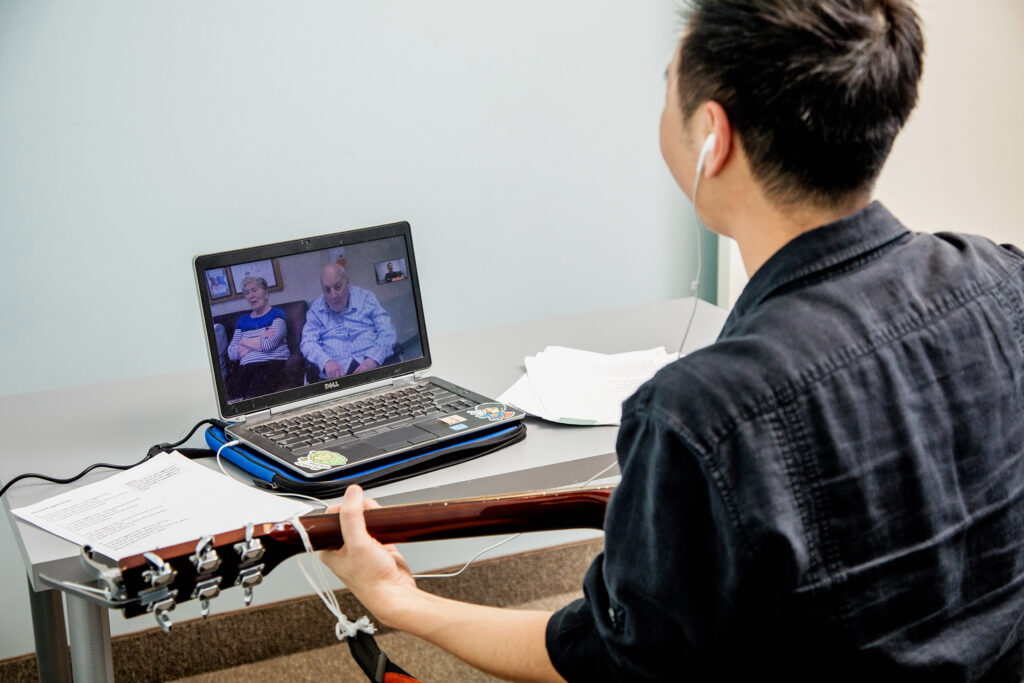What Really Happens In A Music Therapy Session

On the surface a music therapy session can look similar to musical entertainers, group sing-a-longs, or a children’s music program. This is especially true when music therapists use familiar songs. However, there are a lot of things happening under the surface that are not obvious. Music therapists constantly plan, observe and respond to the client in their sessions. This is what sets music therapy apart from other types of music.
Plan, Observe & Respond
Plan:
Music therapy uses music to work on goals. This means that we plan the music, familiar songs & musical activities with intention to work on goals.
Observe:
First the therapist uses planned songs. Next they use observations to determine if the song is effective in supporting the goal. We carefully look for changes in participation, facial expression, body language and emotional state. We observe if the client responds in a way that shows progress.
Respond:
Music therapists respond to their observations throughout their sessions. I like to refer to this as bio-feedback. The music therapist responds to their observations by making changes to the music. This makes sure that the music is always actively supporting the client’s goals.
Mary’s Music Therapy Session
Mary lives in a long-term care home. She is diagnosed with dementia and shows signs of depression. During the assessment, the music therapist takes great care to determine the familiar songs that hold the most meaning for Mary. The music therapist carefully plans the songs that will best support Mary’s goal. When people hear the music therapist singing The Way You Look Tonight it probably looks the same as a musical entertainment. They don’t know that this song is being played for Mary intentionally. This was the song that she danced to with her late husband at her wedding. As a result, this song helps Mary feel more connected to his memory.
During the song the music therapist observes that Mary is trying to sing along but can’t keep up. They respond by slowing the tempo of the song allowing Mary to sing along successfully. The music therapist observes that Mary is smiling. Singing to this meaningful song is bringing her joy. The music therapist responds by singing the song a second time to extend her enjoyment.
John’s Music Therapy Session
John is a three year old boy. He was recently diagnosed with autism. Working with John’s Speech-Language Pathologist John’s goal is increase vocalizations on demand. The music therapist plans Old McDonald in his session. Although John’s mom sings this song at home, she doesn’t know that it was chosen because it provides opportunities to sing vowel sounds and different animal sounds. John’s mom also may not be aware that the music therapist focused on the sheep (baa) and cow (moo) because those sounds are easier to make than oink or neigh.
During the session, the music therapist observes that John is not yet able to sing all the vowels together (e-i-e-i-o). They respond by focusing on just the “o” at the end of each phrase. Next, the music therapist observes that John is not yet able to sing the “o” sound in time with the music. They respond by slowing the tempo and giving more time for John to make his sound. Lastly, the music therapist observes that John has more success when the song is presented slowly and with lots of space. They respond by noting this in the session notes so they will remember to repeat this in the next session.
These fictional examples highlight the process that happens in every music therapy session. Music therapists plan their songs and musical activities, observe their client carefully, and respond to their needs. This is what makes music therapy a clinical process. It is what sets music therapy apart from all other musical experiences.
By Heidi Flynn, RP, MTA
